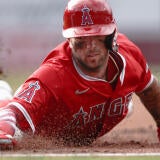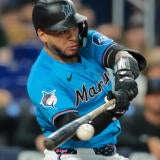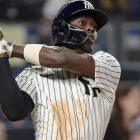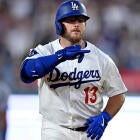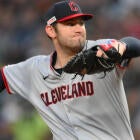Fantasy Baseball: Three things that Nick Kurtz's four homer game and sudden rise to prominence tell us
The rookie was making waves even before his historic day
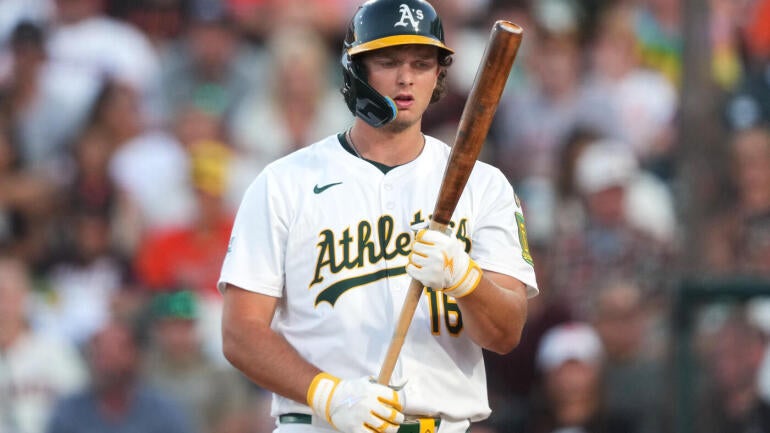
Surely you've heard about the game Nick Kurtz had Friday, a 6 for 6 performance in which he homered four times. Perhaps you haven't stopped to consider the gravity of it, though.
Some of these numbers may be new to you, others not, but just to put the performance in its proper context, let's count the ways it was one for the record books.
- He became the 18th player since 1900 to hit four home runs in a game.
- He came within a foot or so of becoming the first player ever to hit five home runs in a game, his fourth-inning double hitting just below the line demarcating a home run, as you can see here.
- That double, in conjunction with a single and the four home runs, gave him 19 total bases, equaling the mark set by Shawn Green in 2002.
- He scored six runs in all, which may have been the most impressive feat of all. It made him only the ninth player to do that since 1900.
Like I said, one for the record books.
Much has been written about this performance already, seeing as it happened a few days ago, but I wanted the chance to comment on what it means for Fantasy Baseball, because I think there are three major takeaways. We'll begin with the most obvious.
The performance confirms that Kurtz is indeed a Fantasy stud.
This was becoming clear even before the four homer game. His OPS was .982, for crying out loud. He had homered seven times in his previous 16 games. The gasps and whispers had already started.
And now? The gasps and whispers have turned into an ear piercing shriek. Factoring in the four homer game, Kurtz is batting .353 (60 for 170) with 22 home runs and a near 1.300 OPS in his past 45 games. That's right: He's averaged a home run every other game ... for 45 games, more than a quarter of a full length season. It won't surprise you to learn, then, that he's the No. 1 player in Rotisserie leagues during that time, and I, for one, am seeing no reason to doubt him.
I suppose the biggest would be his strikeout rate, which is 31.2 percent overall and not much better during the 45 game streak (28.2 percent). Even if we do Kurtz the courtesy of using that second number, it would rank as the fifth highest among qualifiers, behind Riley Greene, Ryan McMahon, Oneil Cruz, and James Wood. Notice what those players have in common, though. Three of the four are regarded as Fantasy studs or something close to it. Such a strikeout rate isn't a deal breaker.
Of course, it would be fair to say that players with so high of a strikeout rate rarely excel in batting average the way Kurtz seems to be now, but this is where his opposite field tendencies set him apart, making him more difficult to defend. Normally, a low pull rate would be a drawback because it undermines a hitter's power potential, but for one who hits the ball 94.1 mph on average, it's hard to see it as anything other than a plus.
And then there's the pedigree. Kurtz was good enough in college to be drafted fourth overall even as a pure first baseman, and then he slashed .344/.440/.712 over his minor league career. Sure, that minor league career lasted only 33 games, but to put it another way, his minor league career lasted only 33 games. Nothing could slow his momentum. He made a mockery of the whole developmental system and announced himself as a special prospect in doing so. For as much attention as Wyatt Langford's rapid rise through the minors was, Kurtz beat him by 11 games.
And the rest, it turns out, is history.
The performance serves as a reminder that even the best hitting prospects will probably need an adjustment period.
The reason I've reduced Kurtz's excellence to just his past 45 games is because what came before them was pretty abysmal. It seems impossible to fathom now, but as recently as May 19, nearly a month into his big league career, Kurtz was slashing .208/.259/.299. He had homered just once and was striking out at a 36 percent clip.
And some people gave up on him. Despite all the fanfare of his promotion, despite the whirlwind minor league career, despite the fact that we've seen some version of this same scenario play out so many times in recent years, some people decided there was nothing more to see here and cut bait. Kurtz's roster rate in CBS Sports leagues, which had peaked at 84 percent when he was promoted, tumbled all the way to 68 percent.
I have news for those people: It's not 2019 anymore. Maybe I can stop saying that six years later, but expectations seem to have gotten stuck in that wonderfully rare period of time when prospect call ups were all little miracles that would instantaneously reverse your team's fortunes. The difficulty curve is higher now. As has been true for most of major league history, newcomers need time to adjust. Maybe people understand this on an intellectual level, but they seem quick to lose heart when they don't get that little miracle right away.
The loose timeline I've settled on is two months. It's not foolproof, of course. Some prospect call ups still find instant success, like Corbin Carroll a couple years ago. Kurtz himself needed only one month rather than two. But if you look back at some of the biggest rookie successes in recent years -- whether it's Jackson Chourio, Jackson Merrill, Gunnar Henderson, Bobby Witt or Julio Rodriguez -- they pretty much all needed two months to find their footing in the majors.
So, how can you apply this going forward? Well, you can't get a do over on Kurtz, but you can keep the faith on Roman Anthony. You can also remain open to Jac Caglianone finding success once he returns from a hamstring injury. Both players offer reason for optimism beyond their prospect pedigree, but I'm saying that the pedigree itself is reason enough to hold out hope. Even Coby Mayo, whose two months of major league duty have been spread out because of the Orioles' refusal to commit to him fully, is suddenly batting .300 (18 for 60) with three homers and six doubles in his past 22 games after showing us next to nothing in his first 29, his strikeout rate going from 40.5 percent in the 29 to 14.9 percent in the 22. Again, the Orioles' handling of him made it impossible to hold onto him, but my point is that even in the most extreme case of a disappointing prospect call up, the turnaround could come quickly.
The performance positions Kurtz to be the top first baseman drafted next year.
I haven't seen this discussed much, but to me it's increasingly obvious. Every position has its royalty that populates the top of rank lists year after year, but the royalty at first base is looking pretty weathered. Bryce Harper isn't getting any younger. Freddie Freeman certainly isn't. Matt Olson is good but flawed, and Vladimir Guerrero is never quite everything we want him to be. The one member of first base royalty who appeared in my first-two-round redraft for the second half was Pete Alonso, who I wouldn't say is a fixture there and has done his best to eliminate himself in the weeks since.
Kurtz is obviously trending the opposite direction. I've mentioned that he's the top hitter in Rotisserie leagues over his past 45 games, but let's look at his full season production. And let's use Head to Head points since that's his more vulnerable format due to the high strikeout rate. So far this year, only two first basemen are averaging 3.5 points per game or more. Harper is at 3.5 exactly. Kurtz is at 3.9. Only two other first basemen in the past four years have averaged as many as 3.9 points per game: Freeman and Olson in 2023.
So the remaining question is whether Kurtz is legitimate, and I've already made the case for that. I'm not prepared to say he'll sustain a .308 batting average and 1.052 OPS all the way through the end of the season, but the fact he can threaten to as a 22 year old makes him a far more promising investment than players whose best days are clearly behind them or who haven't hinted of that upside in quite some time.
Kurtz strikes me as the sort of transcendent talent who could pace the position for years to come.

